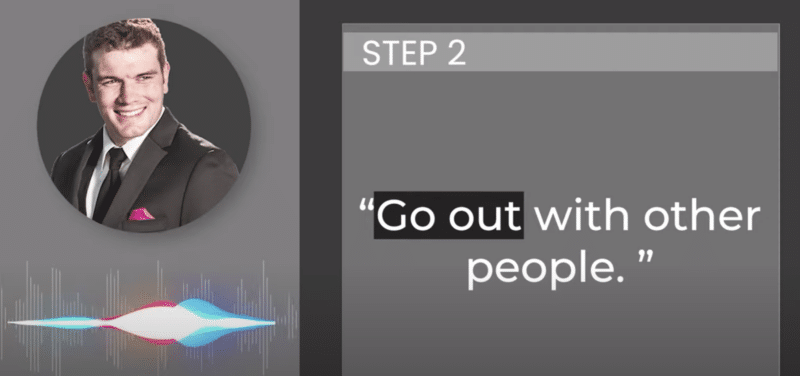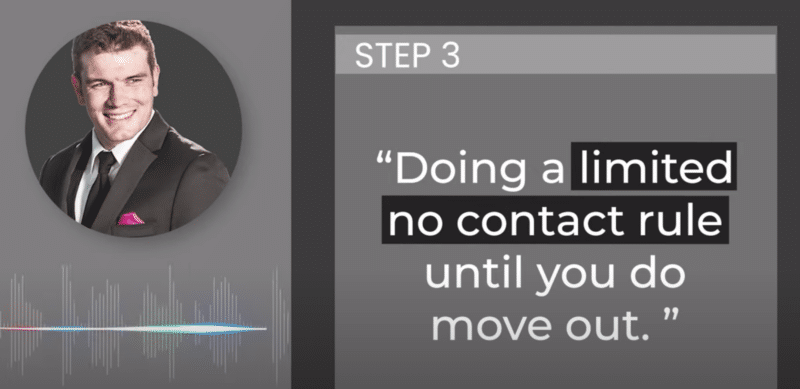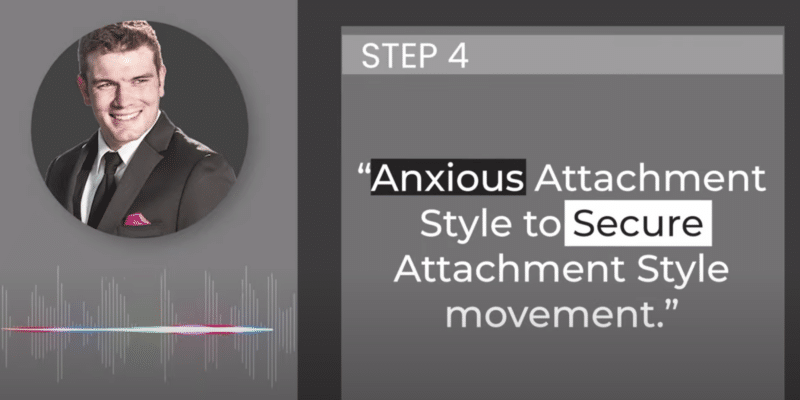Today we’re going to talk about how to get your ex back if you live together with them.
So, if you stick around until the end of this article you’re going to learn,
- Some of the common pitfalls our clients fall into when they still live with their exes.
- Our five step process for getting an ex back in this exact situation.
Enough talk!
Let’s get to it.

What Are Your Chances of Getting Your Ex Girlfriend Back?
Take the quizHow To Get Your Ex Back If You Live Together With Them
Situations where you’re living with your ex are always difficult, because a lot of the times, the situations or the game plan that we’ve created is designed for more general purposes, and what I mean by that is it’s designed for situations where you’re not living with your ex, where usually cheating hasn’t been involved, or there’s no long-distance situation involved, so a lot of the core basic concepts that we come up with on Ex Girlfriend Recovery really don’t apply to situational circumstances.
This is actually one of the reasons why we have so many articles, because there’s so many nuances to getting an ex back in this situation or that situation, and living together is no different.
But what we’ve done is we’ve come up with sort of a five-step process for getting an ex back if you live together, so very quickly, here are the things that we want you to do, and what I’m going to do after I list these things is go in-depth on exactly what I mean by them.
- Have A Plan For Moving Out
- Go Out With Other People
- Begin Limited No Contact Until You Do Move Out
- Shift Your Anxious Attachment To A More Secure One
- Institute The Value Ladder
If this sounds like rocket science to you, don’t worry, I’m going to make it make sense, so let’s just start from the top.
Step One: Have A Plan For Moving Out
The big one is step one, being the plan for moving out.
So this is actually a difficult thing to maybe hear, but one of the things that we tested when we first started Ex Girlfriend Recovery, and even our first website, Ex Boyfriend Recovery, when we saw situations where people were living together with their exes, we actually tried to get them to just simply use what you’re going to learn about later, a limited no contact rule, and the value ladder, and the value chain, and concepts like that, but what we quickly found out was they were ineffective.
Almost always, the concept of the value ladder and the value chain, which we will talk about as step five, was a lot more effective when you weren’t actually living together, so we tried to…
We decided a few years ago to try, for our clients who were living together with exes, to advise them, “Hey, if it’s possible, move away from your ex, move out of the situation entirely.” So we started advising people to do this, and almost instantly we saw much better successes. In fact, one of the situations that…
This is maybe a bit of a tangent off-topic, but one of the situations that we were encountering early on that we were really struggling with was what do you do if you’re living together with an ex, and your ex is dating someone new?
And almost by accident, we advised this client, it was actually a female whose ex literally was with someone else at the time that they were living together, we advised this client to move out, and it actually helped spur us to realize, hey, number one, moving out actually really works, it kind of levels the playing field, but number two, for this particular situation, we actually advise longer periods of no contact, which kind of we’ll talk a little bit about when we talk about the limited no contact and sort of the concept with that, so we almost kind of stumbled upon these two insights just from our very first person who we advised to move out.
So really step one is create a plan, if possible, for moving out, so if you’re living together with your ex, you need to move away from them. Now, this may seem like the worst thing in the world, because I think a lot of the misconception is, “Well, if I’m living together with my ex, that’s such an advantage,” but we find it’s actually not an advantage, it’s a disadvantage, so many things can go wrong, so what we try to do is we try to level the playing field by advising all of our clients who are living together with an ex, if possible, because some people, it’s just not possible, if possible, move out, get your own apartment, become more independent, that’s step one.
Step Two: Begin Going Out With Other People
Step two is begin going out with other people.
Now, most of the time, this is not what you think. A lot of times, I think the natural assumption is, “Okay, so Chris wants me to go out with other people, I need to start finding dates.” Well, yes and no, it doesn’t necessarily have to be dates. What we’re trying to do is we’re trying to show your ex that you are not going to sit around and mope around about the fact that this breakup occurred. A lot of times, we’re finding…
I’m going to admit something here, I probably shouldn’t admit this on air, but I’ve actually not done a study for the men on Ex Girlfriend Recovery, we have done studies for the women on Ex Boyfriend Recovery, we found that pretty much 95% of the clients there have been broken up with by their exes.

What Are Your Chances of Getting Your Ex Girlfriend Back?
Take the quizJust from listening to the voicemails I get, most of the time, we’re finding ex-girlfriends are the ones to break up with our male clients, but I don’t have the proof to back it up, so that is just an assumption I’m rolling on, or rolling with here, but most of the time, when your ex-girlfriend has broken up with you, the narrative that she creates in her head is, “They can’t survive without me.”
And there’s a lot of different reasons for breaking up, sometimes ex-girlfriends will make it seem like this is a mutual breakup, but almost always, it’s never very mutual.
So by going out, you’re showing your ex that number one, they’re not your first priority anymore, number two, they’re nothing more than an acquaintance to you, and number three is you’re not sitting around, moping around depressed, you’re handling the breakup in a mature way.
Now, does this mean you should be going out every single night and partying?
No, that’s almost an over-correction, but we do advise you to go out with other people, all right? Friends, family members, even romantic interests if you want to try dating someone else, this is a good time to do that, because if they’re seeing you come and go at all hours of the night, it’s not as effective as just seeing you come and go from time to time, it just looks like you’re not sitting around moping about the breakup. What you’re trying to do here is you’re trying to make them have this paradigm shift where they literally start wondering, “Did I mean nothing to them?” Because this actually helps create value.
Step Three: The Limited No Contact Rule
Let’s move on to step number three.
So step number three is doing a limited no contact rule until you do move out. All right, so this is where we get a little complicated. If you’re creating a plan for moving out, that actually makes doing a full no contact rule really well, so here’s sort of the controversial thing that we’re going to be saying today.
When you are with your ex, and you’re living together with them, I mean, you’re going to want to do what’s called a limited no contact rule, so we are often talking about the no contact rule as being this period of time where you’re ignoring your ex on purpose, with the intent of outgrowing them.
But when you’re living together with them, it’s kind of hard to ignore them, so you have to do kind of limited no contact, where if you see them, you’re not trying to be rude, you don’t try to start a conversation, but if they’re starting a conversation, you do engage with them, and then sort of give them the bare minimum, and then go back to business.
Now, usually some people who are living together only think they need to do a limited no contact rule and that’s it, so once their 30 days of limited no contact are up, “Cool, that’s it, I’m ready to go, let’s begin talking again.” What we’re finding, and this is going to be hard to hear, is once you do a limited no contact rule, what you need to do is do a full no contact rule once you move out, so that plan for moving out is kind of important.
Longer periods of no contact, we are becoming more and more fans of. We weren’t originally at the beginning, and this is kind of counter-intuitive, but what we’re finding is we’re noticing that a lot of times, exes who break up with you tend to have avoidant tendencies, and there’s almost this time dilation that exists with people who have avoidant tendencies in time during the no contact rule.
So for a quick example, there are four basic attachment styles, you have secure attachment style, anxious attachment style, avoidant attachment style, and fearful attachment style. Let’s throw fearful out, because only 7% of the population has a fearful attachment style, it’s extremely rare for your ex-girlfriend to have one, so let’s just operate under the assumption that there’s three attachment styles, right?
So let’s say you’re doing a 30-day no contact rule. For someone who was a secure attachment style, 30 days is going to feel like 30 days. 30 days will feel normal. For someone with an anxious attachment style, 30 days is going to feel like 60 days. For someone with an avoidant attachment style, 30 days is going to feel like a week to 10 days, so there’s almost this weird time dilation that exists in how we perceive time during the no contact rule, based on our attachment style.
Now, we’re finding most ex-girlfriends tend to be avoidant, so when you’re doing a limited no contact rule, the mere fact that they’re seeing you almost allows that time dilation, even though you’re doing a limited no contact rule, to extend a little bit, which is why we recommend longer periods of no contact. So if you’re doing a limited no contact rule while you’re living together with them, we actually do advise to do a minimum of 30 days real no contact once you do move out. Again, not a popular thing to talk about, but that’s what we’re finding works the best.
Step Four: The Anxious To Secure Attachment Movement
Step four, which is moving your anxious attachment style to a secure attachment style, which really we should probably reframe this as a secure attachment gravity. This is a concept that I’ve talked a lot about recently, but basically I gave you kind of the rundown in the last section, or the last step, about the four major types of attachment styles, secure, anxious, avoidant, fearful. Really there’s only two categories of attachment styles, you have the secure attachment styles and the insecure attachment styles, so as you can imagine, if you have a secure attachment style, you are classified as having a secure attachment style category. On the other hand, if you have an insecure attachment style, that means you could either be an anxious attachment style, an avoidant attachment style, or a fearful attachment style.
Now, we’ve talked about the 7% rule with the fearful, how it’s very rare, but what we’re finding is that most of the people who we work with tend to be anxious, or tend to have anxious personalities, whereas their exes tend to be avoidant. Now, this is a common theme among people with attachment styles, where anxious attachment style people will be attracted to avoidant attachment style people, and then boom, it’s just like two ends of the spectrum meeting, and it’s fire and ice, they just burn up, and it just doesn’t end well.
Well, what we’re finding is the key to success in getting an ex back almost always relies in identifying your attachment style and moving it more towards becoming more secure. So what is a secure attachment style? Well, this is the type of person that when they go through a breakup, allows themselves time to grieve, but ultimately has the understanding that they’re going to be okay, that the world hasn’t ended, that no matter what happens, they’re going to be okay.
Now, someone with an anxious attachment style, on the other hand, will think the world is ending, that they’re not going to be okay if they don’t get their ex back, the world will be over, blah, blah, blah, we get the whole spiel. Someone with an avoidant attachment style values their independence so much that they’re like, “No, I don’t want intimacy with someone, I don’t want a relationship with someone, I want to move on and find someone else that’s going to allow me to be independent.”
So, here’s what we know. If you’re able to identify the fact that maybe you have an anxious personality, and you’re able to move your anxious personality more towards a secure one, there’s almost this gravity that exists towards your partner, where if your partner identifies, and they will know subconsciously, “Wow, there’s something different.” Well, the truth is, you’re just being more secure with yourself, you’re being more confident with yourself. Once they identify, “Wow, this change has occurred with them,” they begin to mimic those changes, because that’s what we do when we’re attracted to someone. So by simply moving your anxious attachment style, or your insecure type of attachment styles to more of a secure attachment style, you can have the marked benefit of doing the same thing with your ex. Now, it’s not a perfect science, it’s not really a science at all, but it is something we have noticed.
Step Five: The Value Ladder

What Are Your Chances of Getting Your Ex Girlfriend Back?
Take the quizSo, doing those four things will help massively, but ultimately you still need to do step five, and step five is to institute the value ladder when you move out. So thus far, let’s kind of talk about, you’ve created a plan for moving out, but while you’re still living together, you’re going out with other people, friends, family, romantic interests. You are doing a limited no contact rule, and you’re doing that secure attachment work internally, but when you move out, that’s when you actually institute the value ladder concept that we’ve come up with.
So, what is the value ladder? I’ve talked a lot about this, more specifically on Ex Boyfriend Recovery, because Ex Girlfriend Recovery, unfortunately, we haven’t updated some of the older pieces of content, but the value ladder is basically this concept, we tried to create this analogy for people that said, “Getting your ex back is a lot like climbing a ladder,” right? So each rung of the ladder, you are using a different medium of conversation, or different method of communication, in building value.
So you do a no contact rule, and then the first thing you do is you initiate conversation with your ex-girlfriend. You do that through text messaging, this is the first rung of the value ladder. When you’re texting your ex, you’re building value to your ex. Once enough value has been built, you move up to the next rung, which is phone calls or video chat, or FaceTime, or I guess people are using Zoom now, Skype isn’t so much a thing anymore, you build value in there.
Then you move up to the next rung, while still building value on the first rung. The next rung, of course, is meetups. Meetups are kind of in this gray area between your ex-girlfriend thinking, “Is this a date, or is this just sort of like a hangout?” That’s considered a meetup. You build value on enough meetups, and then you can begin doing romantic dates, which is the second-to-last value-added layer. Once you build enough value in the romantic date area, while building value in all those other previous rungs that created the foundation, then you move up to the final rung on the ladder, and that’s where you actually ask for your ex-girlfriend back.
Now, I actually always think ex-boyfriends have a distinct advantage over our ex-girlfriend clients, because society dictates that men tend to have to be the ones that ask for their exes back, so guess what? You have the easy way out, you can just directly ask, but you never ever ask for your ex-girlfriend back until you have climbed to the top of that ladder.














